Reflective Journal: Negotiation Strategies in Workplace Conflict
VerifiedAdded on 2022/11/18
|8
|1887
|55
Journal and Reflective Writing
AI Summary
This reflective journal explores a student's experience with workplace negotiation and conflict resolution during an internship in Australia. The journal details a conflict with a colleague regarding work shifts and religious practices, highlighting the use of both positional and interest-based negotiation techniques. The student recounts interactions with HR and management, noting instances of bias and ineffective communication. The journal contrasts the negative experiences with a positive example of constructive negotiation facilitated by an assistant manager, who employed a four-step approach: relational positioning, exploring issues and interests, generating options, and reaching solutions. The student reflects on the importance of cross-cultural competence, emotional intelligence, and the application of negotiation strategies for future career development.

Running head: REFLECTIVE JOURNAL
Negotiation
Name of the Student:
Name of the University:
Author’s Note:
Negotiation
Name of the Student:
Name of the University:
Author’s Note:
Paraphrase This Document
Need a fresh take? Get an instant paraphrase of this document with our AI Paraphraser
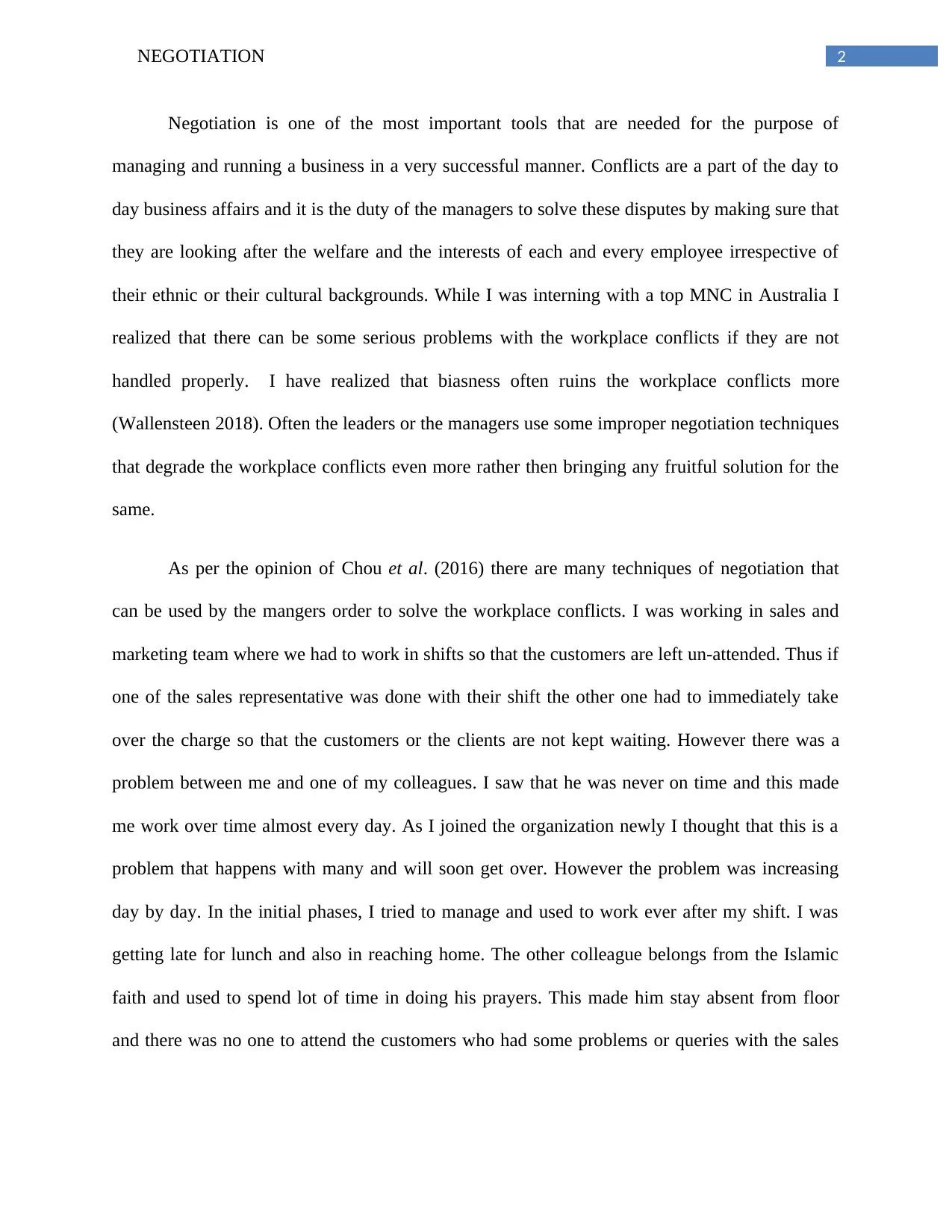
2NEGOTIATION
Negotiation is one of the most important tools that are needed for the purpose of
managing and running a business in a very successful manner. Conflicts are a part of the day to
day business affairs and it is the duty of the managers to solve these disputes by making sure that
they are looking after the welfare and the interests of each and every employee irrespective of
their ethnic or their cultural backgrounds. While I was interning with a top MNC in Australia I
realized that there can be some serious problems with the workplace conflicts if they are not
handled properly. I have realized that biasness often ruins the workplace conflicts more
(Wallensteen 2018). Often the leaders or the managers use some improper negotiation techniques
that degrade the workplace conflicts even more rather then bringing any fruitful solution for the
same.
As per the opinion of Chou et al. (2016) there are many techniques of negotiation that
can be used by the mangers order to solve the workplace conflicts. I was working in sales and
marketing team where we had to work in shifts so that the customers are left un-attended. Thus if
one of the sales representative was done with their shift the other one had to immediately take
over the charge so that the customers or the clients are not kept waiting. However there was a
problem between me and one of my colleagues. I saw that he was never on time and this made
me work over time almost every day. As I joined the organization newly I thought that this is a
problem that happens with many and will soon get over. However the problem was increasing
day by day. In the initial phases, I tried to manage and used to work ever after my shift. I was
getting late for lunch and also in reaching home. The other colleague belongs from the Islamic
faith and used to spend lot of time in doing his prayers. This made him stay absent from floor
and there was no one to attend the customers who had some problems or queries with the sales
Negotiation is one of the most important tools that are needed for the purpose of
managing and running a business in a very successful manner. Conflicts are a part of the day to
day business affairs and it is the duty of the managers to solve these disputes by making sure that
they are looking after the welfare and the interests of each and every employee irrespective of
their ethnic or their cultural backgrounds. While I was interning with a top MNC in Australia I
realized that there can be some serious problems with the workplace conflicts if they are not
handled properly. I have realized that biasness often ruins the workplace conflicts more
(Wallensteen 2018). Often the leaders or the managers use some improper negotiation techniques
that degrade the workplace conflicts even more rather then bringing any fruitful solution for the
same.
As per the opinion of Chou et al. (2016) there are many techniques of negotiation that
can be used by the mangers order to solve the workplace conflicts. I was working in sales and
marketing team where we had to work in shifts so that the customers are left un-attended. Thus if
one of the sales representative was done with their shift the other one had to immediately take
over the charge so that the customers or the clients are not kept waiting. However there was a
problem between me and one of my colleagues. I saw that he was never on time and this made
me work over time almost every day. As I joined the organization newly I thought that this is a
problem that happens with many and will soon get over. However the problem was increasing
day by day. In the initial phases, I tried to manage and used to work ever after my shift. I was
getting late for lunch and also in reaching home. The other colleague belongs from the Islamic
faith and used to spend lot of time in doing his prayers. This made him stay absent from floor
and there was no one to attend the customers who had some problems or queries with the sales
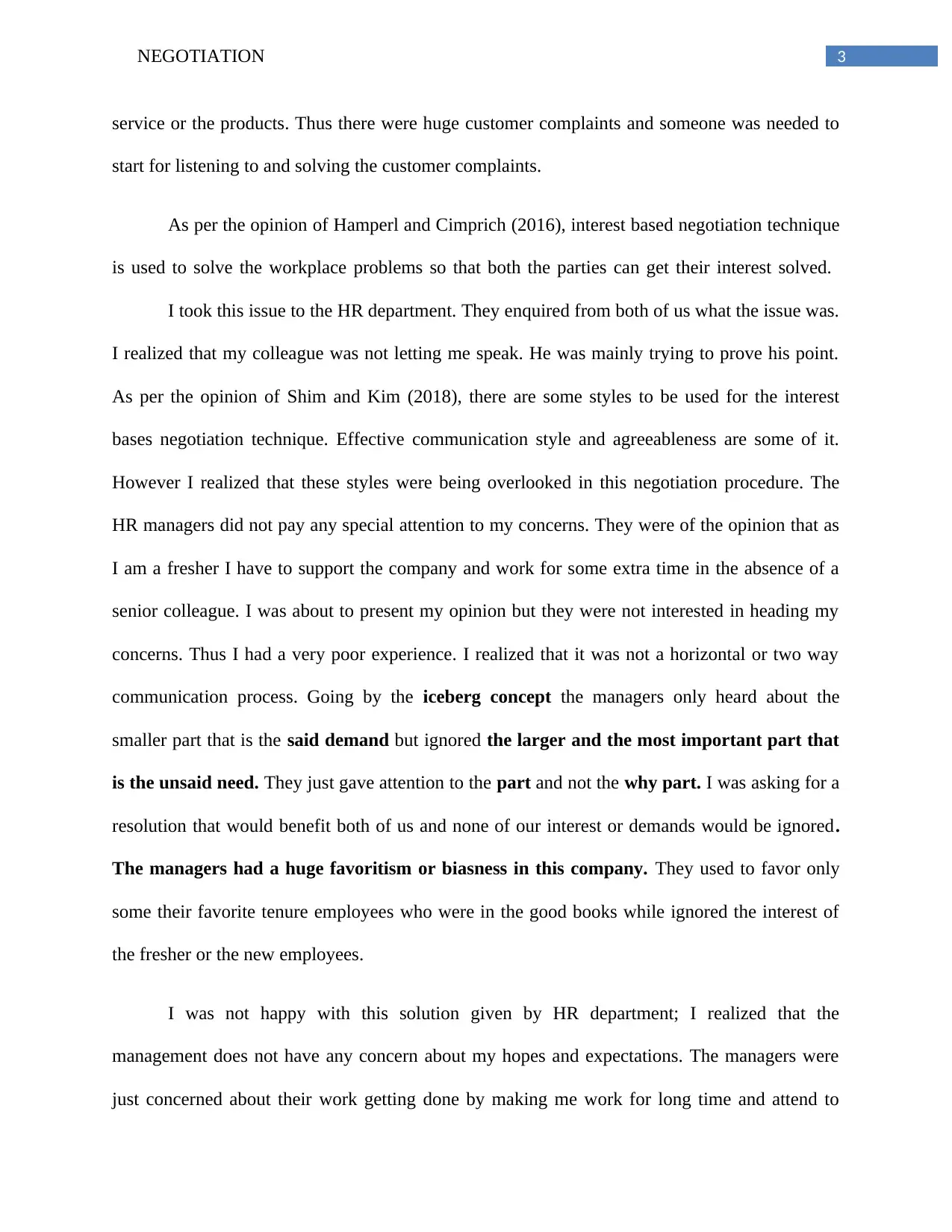
3NEGOTIATION
service or the products. Thus there were huge customer complaints and someone was needed to
start for listening to and solving the customer complaints.
As per the opinion of Hamperl and Cimprich (2016), interest based negotiation technique
is used to solve the workplace problems so that both the parties can get their interest solved.
I took this issue to the HR department. They enquired from both of us what the issue was.
I realized that my colleague was not letting me speak. He was mainly trying to prove his point.
As per the opinion of Shim and Kim (2018), there are some styles to be used for the interest
bases negotiation technique. Effective communication style and agreeableness are some of it.
However I realized that these styles were being overlooked in this negotiation procedure. The
HR managers did not pay any special attention to my concerns. They were of the opinion that as
I am a fresher I have to support the company and work for some extra time in the absence of a
senior colleague. I was about to present my opinion but they were not interested in heading my
concerns. Thus I had a very poor experience. I realized that it was not a horizontal or two way
communication process. Going by the iceberg concept the managers only heard about the
smaller part that is the said demand but ignored the larger and the most important part that
is the unsaid need. They just gave attention to the part and not the why part. I was asking for a
resolution that would benefit both of us and none of our interest or demands would be ignored.
The managers had a huge favoritism or biasness in this company. They used to favor only
some their favorite tenure employees who were in the good books while ignored the interest of
the fresher or the new employees.
I was not happy with this solution given by HR department; I realized that the
management does not have any concern about my hopes and expectations. The managers were
just concerned about their work getting done by making me work for long time and attend to
service or the products. Thus there were huge customer complaints and someone was needed to
start for listening to and solving the customer complaints.
As per the opinion of Hamperl and Cimprich (2016), interest based negotiation technique
is used to solve the workplace problems so that both the parties can get their interest solved.
I took this issue to the HR department. They enquired from both of us what the issue was.
I realized that my colleague was not letting me speak. He was mainly trying to prove his point.
As per the opinion of Shim and Kim (2018), there are some styles to be used for the interest
bases negotiation technique. Effective communication style and agreeableness are some of it.
However I realized that these styles were being overlooked in this negotiation procedure. The
HR managers did not pay any special attention to my concerns. They were of the opinion that as
I am a fresher I have to support the company and work for some extra time in the absence of a
senior colleague. I was about to present my opinion but they were not interested in heading my
concerns. Thus I had a very poor experience. I realized that it was not a horizontal or two way
communication process. Going by the iceberg concept the managers only heard about the
smaller part that is the said demand but ignored the larger and the most important part that
is the unsaid need. They just gave attention to the part and not the why part. I was asking for a
resolution that would benefit both of us and none of our interest or demands would be ignored.
The managers had a huge favoritism or biasness in this company. They used to favor only
some their favorite tenure employees who were in the good books while ignored the interest of
the fresher or the new employees.
I was not happy with this solution given by HR department; I realized that the
management does not have any concern about my hopes and expectations. The managers were
just concerned about their work getting done by making me work for long time and attend to
⊘ This is a preview!⊘
Do you want full access?
Subscribe today to unlock all pages.

Trusted by 1+ million students worldwide
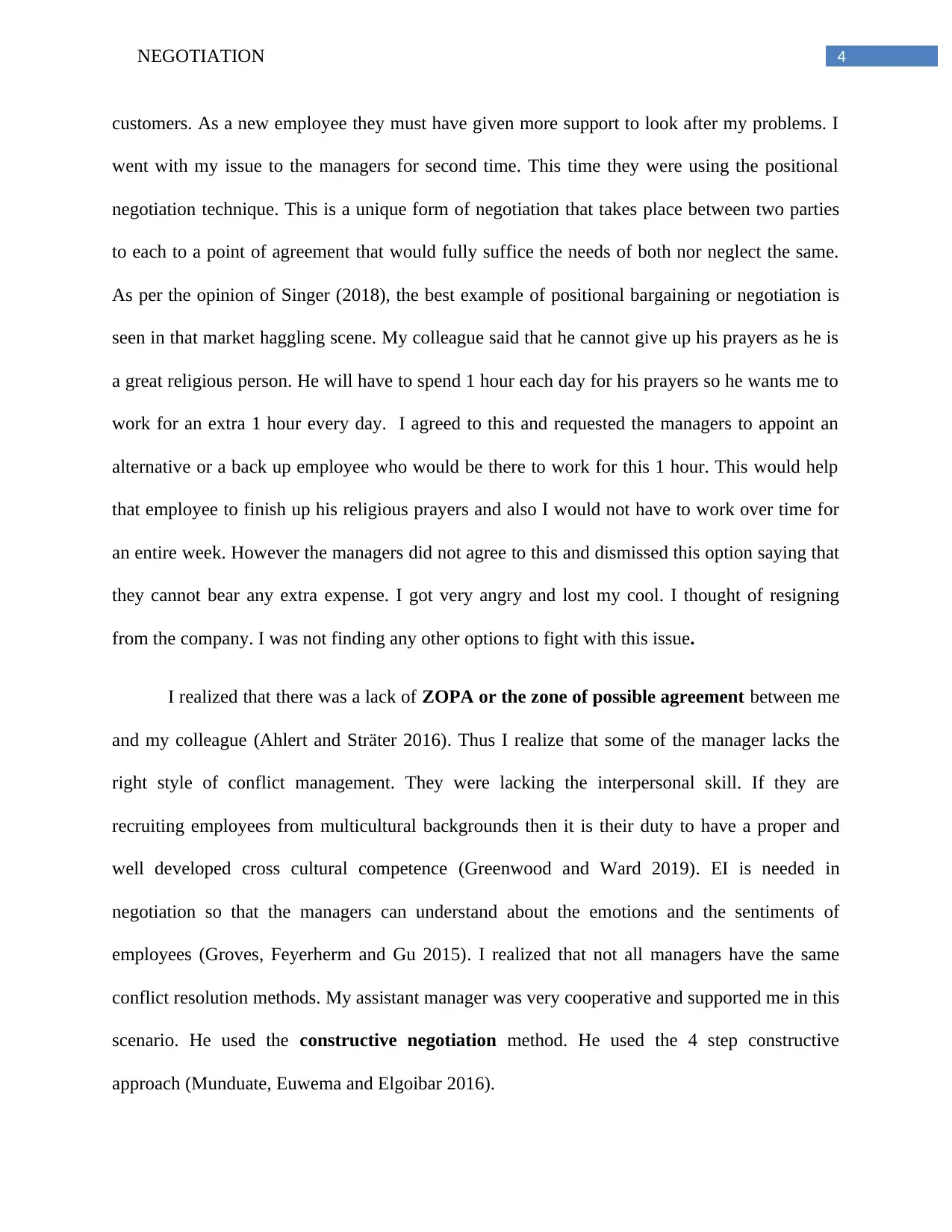
4NEGOTIATION
customers. As a new employee they must have given more support to look after my problems. I
went with my issue to the managers for second time. This time they were using the positional
negotiation technique. This is a unique form of negotiation that takes place between two parties
to each to a point of agreement that would fully suffice the needs of both nor neglect the same.
As per the opinion of Singer (2018), the best example of positional bargaining or negotiation is
seen in that market haggling scene. My colleague said that he cannot give up his prayers as he is
a great religious person. He will have to spend 1 hour each day for his prayers so he wants me to
work for an extra 1 hour every day. I agreed to this and requested the managers to appoint an
alternative or a back up employee who would be there to work for this 1 hour. This would help
that employee to finish up his religious prayers and also I would not have to work over time for
an entire week. However the managers did not agree to this and dismissed this option saying that
they cannot bear any extra expense. I got very angry and lost my cool. I thought of resigning
from the company. I was not finding any other options to fight with this issue.
I realized that there was a lack of ZOPA or the zone of possible agreement between me
and my colleague (Ahlert and Sträter 2016). Thus I realize that some of the manager lacks the
right style of conflict management. They were lacking the interpersonal skill. If they are
recruiting employees from multicultural backgrounds then it is their duty to have a proper and
well developed cross cultural competence (Greenwood and Ward 2019). EI is needed in
negotiation so that the managers can understand about the emotions and the sentiments of
employees (Groves, Feyerherm and Gu 2015). I realized that not all managers have the same
conflict resolution methods. My assistant manager was very cooperative and supported me in this
scenario. He used the constructive negotiation method. He used the 4 step constructive
approach (Munduate, Euwema and Elgoibar 2016).
customers. As a new employee they must have given more support to look after my problems. I
went with my issue to the managers for second time. This time they were using the positional
negotiation technique. This is a unique form of negotiation that takes place between two parties
to each to a point of agreement that would fully suffice the needs of both nor neglect the same.
As per the opinion of Singer (2018), the best example of positional bargaining or negotiation is
seen in that market haggling scene. My colleague said that he cannot give up his prayers as he is
a great religious person. He will have to spend 1 hour each day for his prayers so he wants me to
work for an extra 1 hour every day. I agreed to this and requested the managers to appoint an
alternative or a back up employee who would be there to work for this 1 hour. This would help
that employee to finish up his religious prayers and also I would not have to work over time for
an entire week. However the managers did not agree to this and dismissed this option saying that
they cannot bear any extra expense. I got very angry and lost my cool. I thought of resigning
from the company. I was not finding any other options to fight with this issue.
I realized that there was a lack of ZOPA or the zone of possible agreement between me
and my colleague (Ahlert and Sträter 2016). Thus I realize that some of the manager lacks the
right style of conflict management. They were lacking the interpersonal skill. If they are
recruiting employees from multicultural backgrounds then it is their duty to have a proper and
well developed cross cultural competence (Greenwood and Ward 2019). EI is needed in
negotiation so that the managers can understand about the emotions and the sentiments of
employees (Groves, Feyerherm and Gu 2015). I realized that not all managers have the same
conflict resolution methods. My assistant manager was very cooperative and supported me in this
scenario. He used the constructive negotiation method. He used the 4 step constructive
approach (Munduate, Euwema and Elgoibar 2016).
Paraphrase This Document
Need a fresh take? Get an instant paraphrase of this document with our AI Paraphraser
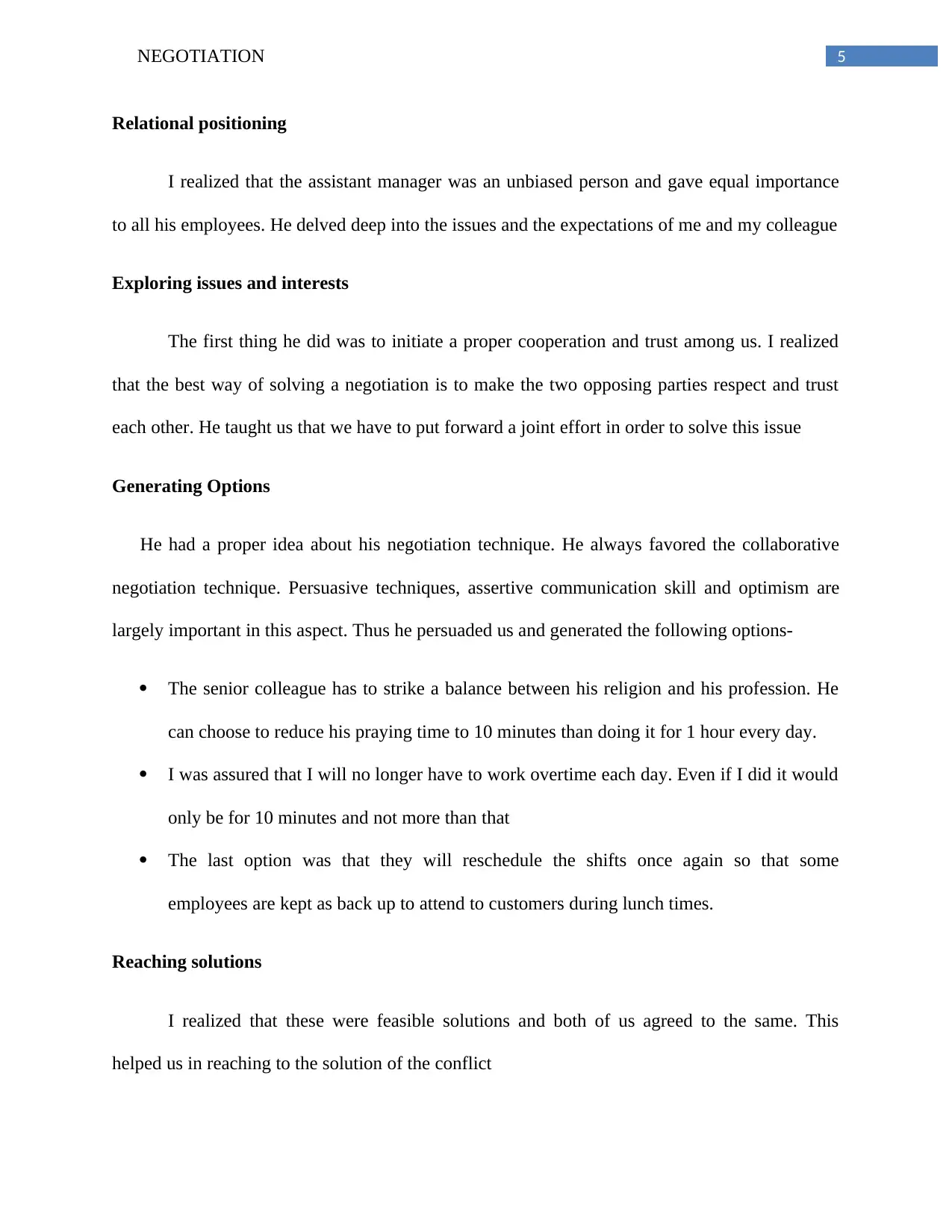
5NEGOTIATION
Relational positioning
I realized that the assistant manager was an unbiased person and gave equal importance
to all his employees. He delved deep into the issues and the expectations of me and my colleague
Exploring issues and interests
The first thing he did was to initiate a proper cooperation and trust among us. I realized
that the best way of solving a negotiation is to make the two opposing parties respect and trust
each other. He taught us that we have to put forward a joint effort in order to solve this issue
Generating Options
He had a proper idea about his negotiation technique. He always favored the collaborative
negotiation technique. Persuasive techniques, assertive communication skill and optimism are
largely important in this aspect. Thus he persuaded us and generated the following options-
The senior colleague has to strike a balance between his religion and his profession. He
can choose to reduce his praying time to 10 minutes than doing it for 1 hour every day.
I was assured that I will no longer have to work overtime each day. Even if I did it would
only be for 10 minutes and not more than that
The last option was that they will reschedule the shifts once again so that some
employees are kept as back up to attend to customers during lunch times.
Reaching solutions
I realized that these were feasible solutions and both of us agreed to the same. This
helped us in reaching to the solution of the conflict
Relational positioning
I realized that the assistant manager was an unbiased person and gave equal importance
to all his employees. He delved deep into the issues and the expectations of me and my colleague
Exploring issues and interests
The first thing he did was to initiate a proper cooperation and trust among us. I realized
that the best way of solving a negotiation is to make the two opposing parties respect and trust
each other. He taught us that we have to put forward a joint effort in order to solve this issue
Generating Options
He had a proper idea about his negotiation technique. He always favored the collaborative
negotiation technique. Persuasive techniques, assertive communication skill and optimism are
largely important in this aspect. Thus he persuaded us and generated the following options-
The senior colleague has to strike a balance between his religion and his profession. He
can choose to reduce his praying time to 10 minutes than doing it for 1 hour every day.
I was assured that I will no longer have to work overtime each day. Even if I did it would
only be for 10 minutes and not more than that
The last option was that they will reschedule the shifts once again so that some
employees are kept as back up to attend to customers during lunch times.
Reaching solutions
I realized that these were feasible solutions and both of us agreed to the same. This
helped us in reaching to the solution of the conflict
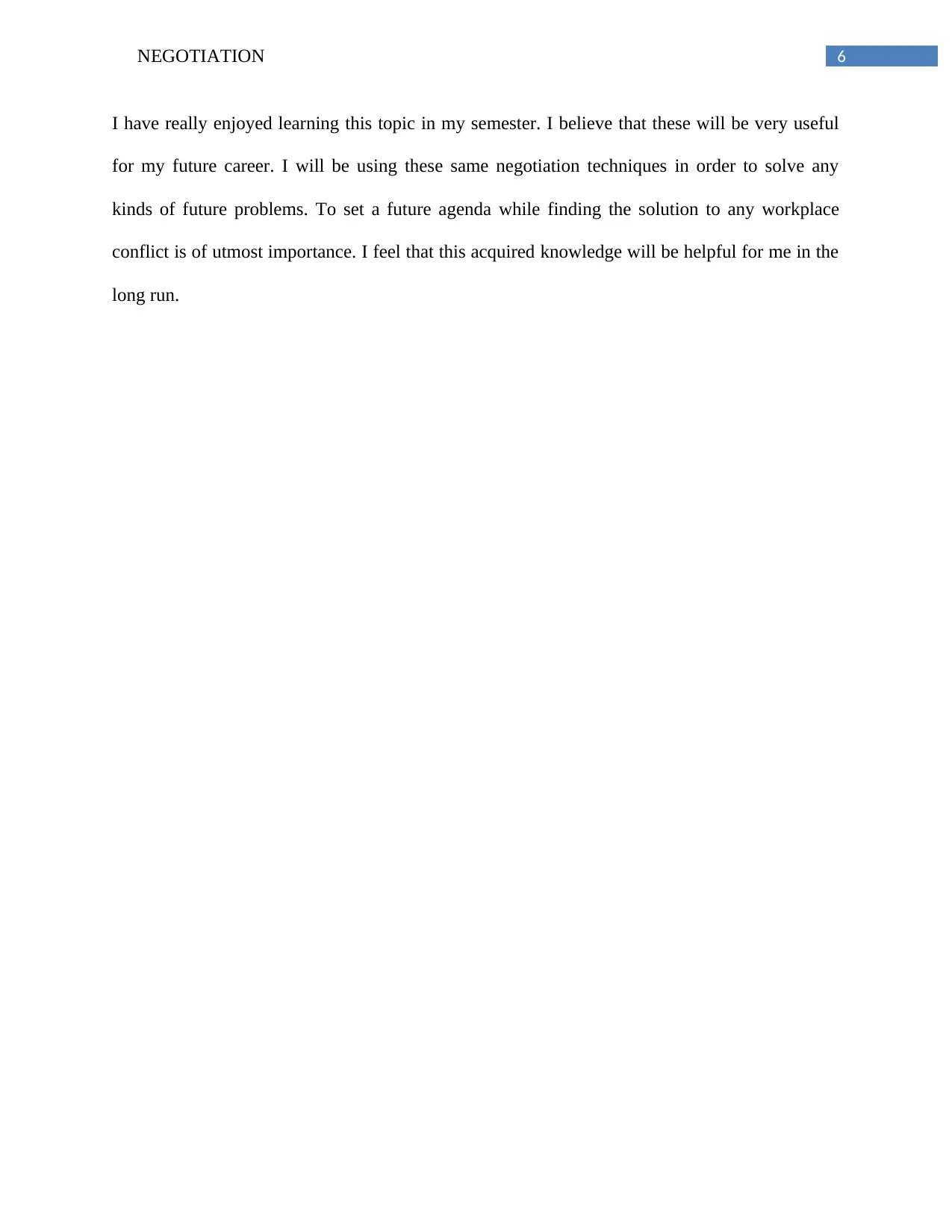
6NEGOTIATION
I have really enjoyed learning this topic in my semester. I believe that these will be very useful
for my future career. I will be using these same negotiation techniques in order to solve any
kinds of future problems. To set a future agenda while finding the solution to any workplace
conflict is of utmost importance. I feel that this acquired knowledge will be helpful for me in the
long run.
I have really enjoyed learning this topic in my semester. I believe that these will be very useful
for my future career. I will be using these same negotiation techniques in order to solve any
kinds of future problems. To set a future agenda while finding the solution to any workplace
conflict is of utmost importance. I feel that this acquired knowledge will be helpful for me in the
long run.
⊘ This is a preview!⊘
Do you want full access?
Subscribe today to unlock all pages.

Trusted by 1+ million students worldwide
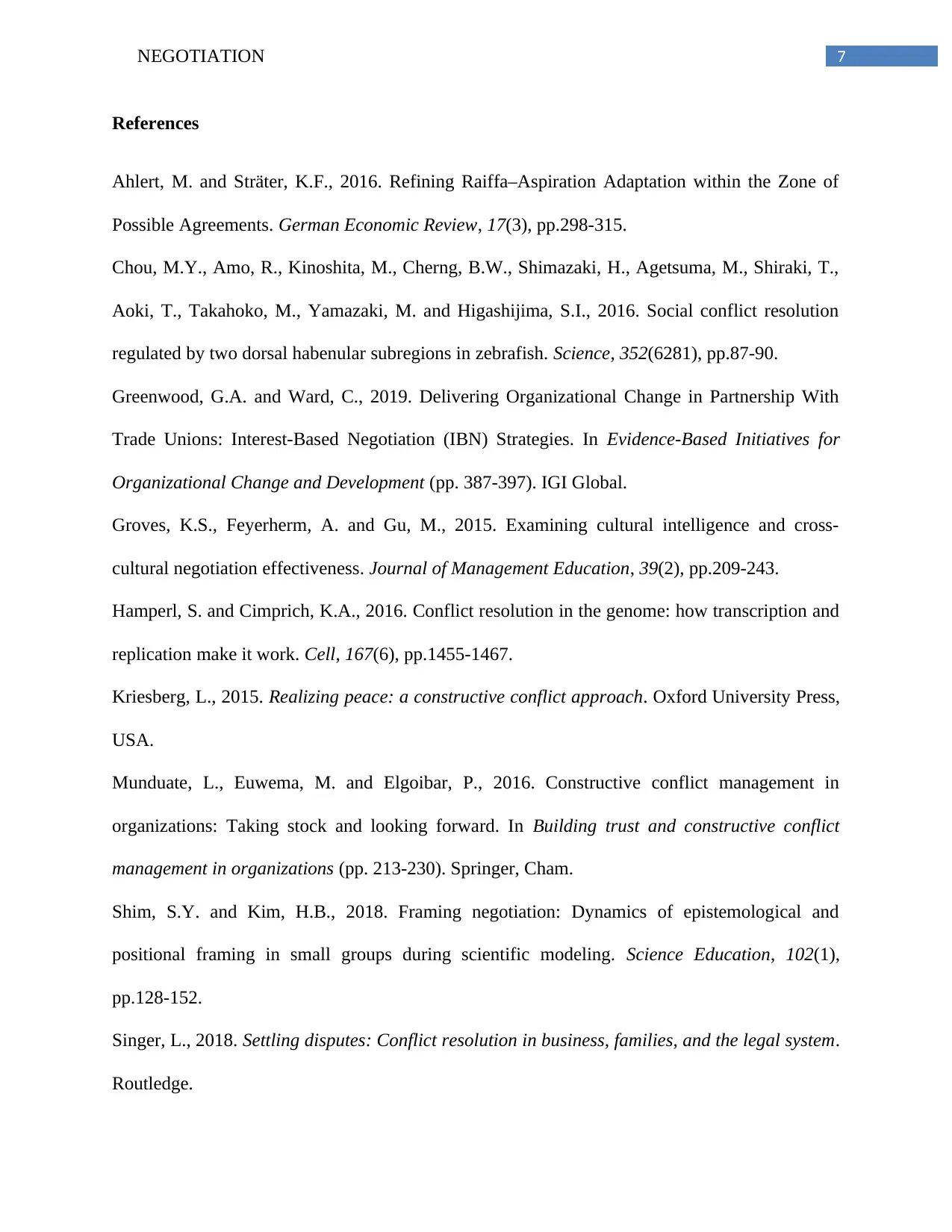
7NEGOTIATION
References
Ahlert, M. and Sträter, K.F., 2016. Refining Raiffa–Aspiration Adaptation within the Zone of
Possible Agreements. German Economic Review, 17(3), pp.298-315.
Chou, M.Y., Amo, R., Kinoshita, M., Cherng, B.W., Shimazaki, H., Agetsuma, M., Shiraki, T.,
Aoki, T., Takahoko, M., Yamazaki, M. and Higashijima, S.I., 2016. Social conflict resolution
regulated by two dorsal habenular subregions in zebrafish. Science, 352(6281), pp.87-90.
Greenwood, G.A. and Ward, C., 2019. Delivering Organizational Change in Partnership With
Trade Unions: Interest-Based Negotiation (IBN) Strategies. In Evidence-Based Initiatives for
Organizational Change and Development (pp. 387-397). IGI Global.
Groves, K.S., Feyerherm, A. and Gu, M., 2015. Examining cultural intelligence and cross-
cultural negotiation effectiveness. Journal of Management Education, 39(2), pp.209-243.
Hamperl, S. and Cimprich, K.A., 2016. Conflict resolution in the genome: how transcription and
replication make it work. Cell, 167(6), pp.1455-1467.
Kriesberg, L., 2015. Realizing peace: a constructive conflict approach. Oxford University Press,
USA.
Munduate, L., Euwema, M. and Elgoibar, P., 2016. Constructive conflict management in
organizations: Taking stock and looking forward. In Building trust and constructive conflict
management in organizations (pp. 213-230). Springer, Cham.
Shim, S.Y. and Kim, H.B., 2018. Framing negotiation: Dynamics of epistemological and
positional framing in small groups during scientific modeling. Science Education, 102(1),
pp.128-152.
Singer, L., 2018. Settling disputes: Conflict resolution in business, families, and the legal system.
Routledge.
References
Ahlert, M. and Sträter, K.F., 2016. Refining Raiffa–Aspiration Adaptation within the Zone of
Possible Agreements. German Economic Review, 17(3), pp.298-315.
Chou, M.Y., Amo, R., Kinoshita, M., Cherng, B.W., Shimazaki, H., Agetsuma, M., Shiraki, T.,
Aoki, T., Takahoko, M., Yamazaki, M. and Higashijima, S.I., 2016. Social conflict resolution
regulated by two dorsal habenular subregions in zebrafish. Science, 352(6281), pp.87-90.
Greenwood, G.A. and Ward, C., 2019. Delivering Organizational Change in Partnership With
Trade Unions: Interest-Based Negotiation (IBN) Strategies. In Evidence-Based Initiatives for
Organizational Change and Development (pp. 387-397). IGI Global.
Groves, K.S., Feyerherm, A. and Gu, M., 2015. Examining cultural intelligence and cross-
cultural negotiation effectiveness. Journal of Management Education, 39(2), pp.209-243.
Hamperl, S. and Cimprich, K.A., 2016. Conflict resolution in the genome: how transcription and
replication make it work. Cell, 167(6), pp.1455-1467.
Kriesberg, L., 2015. Realizing peace: a constructive conflict approach. Oxford University Press,
USA.
Munduate, L., Euwema, M. and Elgoibar, P., 2016. Constructive conflict management in
organizations: Taking stock and looking forward. In Building trust and constructive conflict
management in organizations (pp. 213-230). Springer, Cham.
Shim, S.Y. and Kim, H.B., 2018. Framing negotiation: Dynamics of epistemological and
positional framing in small groups during scientific modeling. Science Education, 102(1),
pp.128-152.
Singer, L., 2018. Settling disputes: Conflict resolution in business, families, and the legal system.
Routledge.
Paraphrase This Document
Need a fresh take? Get an instant paraphrase of this document with our AI Paraphraser

8NEGOTIATION
Wallensteen, P., 2018. Understanding conflict resolution. SAGE Publications Limited.
Wallensteen, P., 2018. Understanding conflict resolution. SAGE Publications Limited.
1 out of 8
Related Documents
Your All-in-One AI-Powered Toolkit for Academic Success.
+13062052269
info@desklib.com
Available 24*7 on WhatsApp / Email
![[object Object]](/_next/static/media/star-bottom.7253800d.svg)
Unlock your academic potential
Copyright © 2020–2025 A2Z Services. All Rights Reserved. Developed and managed by ZUCOL.





